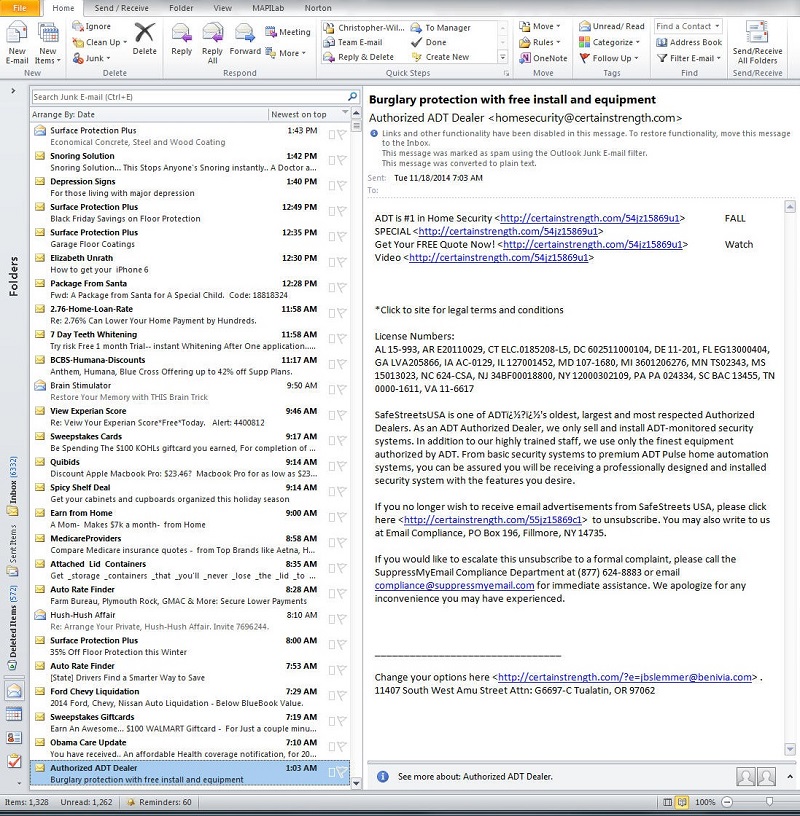There are affiliate links on this page.
Read our disclosure policy to learn more.
Translate this page to any language by choosing a language in the box below.
Spam - What It Is and What You Can Do About It!
Examples of Spam Emails and Spamming
Most of us receive so much spam, we don't need to see another one to know what spam is. This page provides links to reecent examples of spam emails. Also see this page for a detailed description of spam and what to do about it.
Examples of spam emails:
- Spam emails coming from .link domains
- "Brain.Stimulator", Memory, Alzheimers
- Child Predator Warning
- Dr. Oz Mega Weight Loss and more examples
- "High quality replica watches"
- Online Pharmacy
- Online Casino
- Online education /online degrees
- Invitation to Bid on Transformers
If you are a U.S. citizen or resident who receives a spam email that you think is deceptive, forward it to spam@uce.gov. The FTC uses the spam stored in this database to pursue law enforcement actions against people who send deceptive email.
And don't think for a moment that the "sent from" or "reply to" addresses are real.. or really who sent it. See this page about spoofing!
If you are interested in the costs and psychology behind spam, see this page!
How to protect from getting spam
- Don't click on the "unsubscribe" links in the email if you don't recognize the sender or company sending the mail. That simply confirms your address is real to the spammer
- Don't ever reply to spam - again, that simply confirms your address to the spammer. Never write back and ask to be taken off the list
- Don't offer your email address to any websites that don't have a privacy policy
- Don't publish your e-mail address on any Web site or discussion forum. If necessary, obfuscate e-mail address: for example, write an e-mail address as "myname at mycompany dot com."
- Use a separate e-mail address (such as a free Yahoo, Hotmail or Gmail account) to sign up for newsletters, online posting, trade shows and anything you respond to on the internet. If the mailbox gets unwieldy, you can delete it or filter it more aggressively.
- Use anti-spam software.
- Try to filter your email - a link at the scam busters site will show you exactly how to do this. Or your ISP might provide a filtering service or be able to tell you how to set one up yourself.
- Don't ever buy anything from spammers.
- Don't write to or give your email address out to clueless folks, whether they are friends or family. Inevitably, those people will fail to use up-to-date firewalls, ant-virus, anti-spyware, and they will visit dubious scam websites. Sooner or later, their pc will become infected, and the virus or worm will harvest all of the email addresses in their Outlook or other email client.
- How to Stop Spam almost forever! You don't have to face an inbox full of porn, spam, scams and junk every day. Here's how to stop it.
What to do if you DO get spam:
- Don't unsubscribe immediately. After a few weeks, compare the messages you want to unsubscribe from and look for common traits, such as common strings of text that you can use to block further mail.
- Do complain to your internet service provider (ISP) and to the spammer's ISP - and remember to include the junk mail's entire header
- Check here for a list of companies that use spam to promote their products - never purchase anything from these companies. Send us a copy of spam and we will add the company to the list.
- If the spammer is a US address, email your spam to the spam recycling centre at spamrecycle@ChooseYourMail.com (they will forward the message to state and federal authorities
- Click here to see a list of spam email, with images of the actual email and their website. You can use this to compare against the spam you receive and report them to the FTC!
- Do set up a private email address for friends and associates and use a free web-based email address (like Yahoo or Hotmail) for any interactions you have with other websites and companies
For a comprehensive list of national and international agencies to report scams, see this page.
Examples of an Outlook Inbox full of spam:
